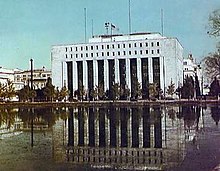Supreme Commander for the Allied Powers

Supreme Commander for the Allied Powers ( SCAP ; German " Supreme Commander for the Allied Powers "; often mistakenly Supreme Commander of the Allied Powers ) was the title of General Douglas MacArthur and his successor, General Matthew B. Ridgway , during the occupation of Japan .
Overview
Although there were several Allied commanders in chief during and after World War II , the name SCAP was only used in Japan. There, SCAP designated not only the post itself, but also the associated occupation authorities; the designation GHQ (English for General Headquarters ) was also used for these .
The GHQ was initially located in Yokohama, but was relocated to Tokyo on September 8, 1945. The GHQ initially only had military employees, but by August 1947 17 non-military departments were added, at the highest level:
- Diplomatic Department,
- International Law Enforcement Department,
- Law Department,
and on the next level, u. a:
- Department for the Protection of Private Property,
- Department of Public Welfare and Health,
- Information and Education Department,
- Education Department,
- Government Department,
- Economics and Science Department,
- Natural Resources Department,
- Public Transport Department.
The GHQ was the sole executive power of the Allies, even on occasions when the GHQ the "Allied Council for Japan" (連 合 国 対 日 理事会, Rengokoku Tainichi Rijikai) should have consulted. The GHQ, for example, worked exclusively on instructions from the American government, and the large administrative body employed almost exclusively Americans. The tensions between the Allies that arose after 1945 reinforced this trend.
The occupation policy was formally implemented through the Japanese Reichstag, which, in fundamental contrast to the situation in the German Reich, continued to act as a legislative body. Conversely, the approval of the SCAP was necessary for all Japanese initiatives.
In November 1951 McArthur was replaced by General Ridgway. - With the entry into force of the peace treaty of San Francisco and thus the end of the occupation statute, the post became obsolete in 1952.
literature
- S. Noma (Ed.): SCAP . In: Japan. An Illustrated Encyclopedia. Kodansha, 1993, ISBN 4-06-205938-X , p. 1324.
- Hunter, Janet: SCAP . In: Concise Dictionary of Modern Japanese History. Kodansha International, 1984. ISBN 4-7700-1193-8 .